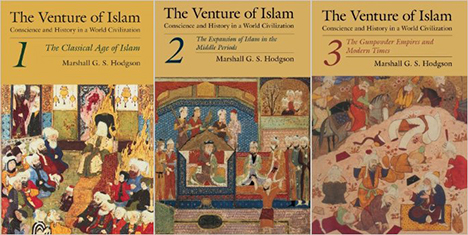
Bruce Lawrence has written an interesting reflective essay on the work of Marshall Hodgson for the online Marginalia page of the Los Angeles Review of Books. I attach the start of the essay here.
Marshall Hodgson was both a genius and a visionary. While he may have seemed to be just another university professor, at once restless, innovative, and genial, he was also an academic Ãœbermensch with a global agenda. He wanted to change the world by changing the way we saw, understood, and engaged Islam within world history. Born in 1922, he was drafted but as a Quaker refused to fight in World War II. After serving five years in detention camp, he returned to school, graduating from the University of Chicago with a PhD in the early 1950s. He had been teaching from the notes that became The Venture of Islam for over a decade before his demise in 1968. Forty-six years after his death, and 40 years since the posthumous publication of his magnum opus, his legacy remains puzzling. Was he ahead of his time, or has he been overtaken by the Cold War and its aftermath, including the horror of 9/11, along with its own, persistent aftermath?
Hodgson was informed, above all, by a moral vision of world history. He thought that Islam mattered because it righted the intellectually wrong yet emotively triumphalist notions of Eurocentric domination in world history. Hodgson began by expanding the backdrop for Islam to include the emergence of all historically documented societies. He stressed the formative features of world civilization dating from 3 millennia before the Common Era. By 1500 BCE, there had emerged four core cultural areas: Mediterranean, Nile-to-Oxus, Indian, and Chinese. It was two rivers, the Nile to the south and Oxus to the north, which provided the map markers etching the core area of what became Islamicate civilization. There was no Middle East or Near East, since in each case these qualifiers presumed an absent center: middle to where? near from where? east of where? Instead, it was these two major waterways, the Nile and the Oxus, which framed major developments characterizing the earliest three phases of Islamicate civilization. They are best viewed in alliterative or assonant pairs.
The first phase Hodgson called Formation and Orientation (500-634), which ends after the death of the Prophet Muhammad and his initial successor, Abu Bakr. The second is a phase of Conversion and Crystallization (634-870). Though Islamic rule comes to prevail, there are not yet Muslim majorities in all regions under Islamic rule. The third phase is Fragmentation and Florescence (970-1041), as Muslim polities splinter while Islam itself emerges as a major civilizational force for the first time.
What follows is no less important but not as easily summarized as those first centuries of Islamic expansion and rule. A fourth phase, Migration and Renewal (1041-1405), carries us through the early Mongol invasions and the aftermath of Tamerlane. It is followed by a fifth phase of Consolidation and Expansion (1405-1683); Hodgson ends this period with a glance at Indian Ocean Islam after reviewing the three land-based empires, Ottoman, Safavid, and Mughal (or Indo-Timuri). Finally, there crystallizes the sixth phase of Reform, Dependency, and Recovery (1683-present); completed after Hodgson’s death, it includes a postlude from WW II to the present,titled “Islam and Globalization: the Age of Mobilityâ€. [See “the Islamic Worldâ€, an epitome by Hodgson’s former student, Marilyn Waldman, along with Malika Zeghal, in Encyclopaedia Britannica online.]
Here in nuce is what Hodgson argued about the importance of seeing Islam over the timeframe of 1500 years but with an emplotment that was closer to 3000 years. The interaction of the known world is crucial. The Nile-to-Oxus, the future core of Islamdom, was the least cohesive and the most complicated of the four cultural core areas. Whereas each of the other regions developed a single language of high culture — Greek, Sanskrit, and Chinese, respectively — the Nile-to-Oxus region was a linguistic palimpsest of Irano-Semitic languages of several sorts: Aramaic, Syriac (eastern or Iranian Aramaic), and Middle Persian (the language of eastern Iran). The Nile-to-Oxus region, of course, became conjoined with the Arabian Peninsula through the expansion of early Muslim rule to neighboring regions, but the nature of the society, culture, and religion that evolved was bi-directional. Though the Arabs conquered, the people, the institutions, and the societies they conquered challenged and changed them. The crucial period is 800-200 BCE, known as the Axial Age because the world’s first religions of salvation developed in each of the four core areas, and from these traditions — for example, Judaism, Mazdeism, Buddhism, and Confucianism — derived all later forms of high religion, including Christianity and Islam.
For the rest of this essay, click here.